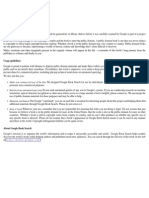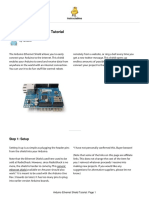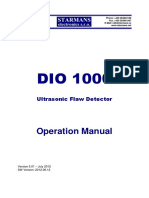Arduino - WebServer
Uploaded by
Tanmay MoharanaArduino - WebServer
Uploaded by
Tanmay Moharana12/13/13
Arduino - WebServer
Web Server
In this example, you will use your Ethernet Shield and your Arduino to create
a simple Web server. Using the Ethernet library, your device will be able to
answer a HTTP request with your Ethernet shield. After opening a browser and
navigating to your Ethernet shield's IP address, your Arduino will respond with
just enough HTML for a browser to display the input values from all six analog
pins.
Hardware Required
Arduino Ethernet Shield
Shield-compatible Arduino board
Circuit
The Ethernet shield allows you to connect a WizNet Ethernet controller to the
Arduino via the SPI bus. It uses pins 10, 11, 12, and 13 for the SPI connection
to the WizNet. Later models of the Ethernet shield also have an SD Card on
board. Digital pin 4 is used to control the slave select pin on the SD card.
The shield should be connected to a network with an ethernet cable. You will
need to change the network settings in the program to correspond to your
network.
arduino.cc/en/Tutorial/WebServer
1/4
12/13/13
Arduino - WebServer
image developed using Fritzing. For more circuit examples, see the Fritzing project page
In the above image, your Arduino would be stacked below the Ethernet shield.
Schematic
Code
/*
Web Server
arduino.cc/en/Tutorial/WebServer
A simple web server that shows
the value of the analog input pins.
using an Arduino Wiznet Ethernet shield.
2/4
12/13/13
Arduino - WebServer
Circuit:
* Ethernet shield attached to pins 10, 11, 12, 13
* Analog inputs attached to pins A0 through A5 (optional)
created 18 Dec 2009
by David A. Mellis
modified 9 Apr 2012
by Tom Igoe
*/
#include <SPI.h>
#include <Ethernet.h>
// Enter a MAC address and IP address for your controller below.
// The IP address will be dependent on your local network:
byte mac[] = {
0xDE, 0xAD, 0xBE, 0xEF, 0xFE, 0xED };
IPAddress ip(192,168,1,177);
// Initialize the Ethernet server library
// with the IP address and port you want to use
// (port 80 is default for HTTP):
EthernetServer server(80);
void setup() {
// Open serial communications and wait for port to open:
Serial.begin(9600);
while (!Serial) {
; // wait for serial port to connect. Needed for Leonardo only
}
// start the Ethernet connection and the server:
Ethernet.begin(mac, ip);
server.begin();
Serial.print("server is at ");
Serial.println(Ethernet.localIP());
}
void loop() {
// listen for incoming clients
EthernetClient client = server.available();
if (client) {
Serial.println("new client");
// an http request ends with a blank line
boolean currentLineIsBlank = true;
while (client.connected()) {
if (client.available()) {
char c = client.read();
Serial.write(c);
// if you've gotten to the end of the line (received a newline
// character) and the line is blank, the http request has ended,
// so you can send a reply
if (c == '\n' && currentLineIsBlank) {
// send a standard http response header
client.println("HTTP/1.1 200 OK");
client.println("Content-Type: text/html");
client.println("Connection: close"); // the connection will be closed after completion of the response
client.println("Refresh: 5"); // refresh the page automatically every 5 sec
client.println();
client.println("<!DOCTYPE HTM L>");
client.println("<html>");
// output the value of each analog input pin
arduino.cc/en/Tutorial/WebServer
for (int analogChannel = 0; analogChannel < 6;analogChannel++) {
int sensorReading = analogRead(analogChannel);
3/4
12/13/13
Arduino - WebServer
client.print("analog input ");
client.print(analogChannel);
client.print(" is ");
client.print(sensorReading);
client.println("<br />");
}
client.println("</html>");
break;
}
if (c == '\n') {
// you're starting a new line
currentLineIsBlank = true;
}
else if (c != '\r') {
// you've gotten a character on the current line
currentLineIsBlank = false;
}
}
}
// give the web browser time to receive the data
delay(1);
// close the connection:
client.stop();
Serial.println("client disconnected");
}
}
arduino.cc/en/Tutorial/WebServer
4/4
You might also like
- Network Security All-in-one: ASA Firepower WSA Umbrella VPN ISE Layer 2 SecurityFrom EverandNetwork Security All-in-one: ASA Firepower WSA Umbrella VPN ISE Layer 2 SecurityNo ratings yet
- Arduino and Genuino 101 Development Workshop - Agus Kurniawan Part 020No ratings yetArduino and Genuino 101 Development Workshop - Agus Kurniawan Part 0205 pages
- Arduino Ethernet Shield Web Server Tutorial100% (5)Arduino Ethernet Shield Web Server Tutorial114 pages
- Arduino Ethernet Shield Web Server TutorialNo ratings yetArduino Ethernet Shield Web Server Tutorial12 pages
- Lecture Topic 3.2.1 Arduino With Ethernet ShieldNo ratings yetLecture Topic 3.2.1 Arduino With Ethernet Shield31 pages
- Control An LED Over The Internet Using The Arduino Ethernet ShieldNo ratings yetControl An LED Over The Internet Using The Arduino Ethernet Shield6 pages
- Arduino W5100 Test: 1.stack Your W5100 Shield On You Arduino Board, Make Sure All The Pins Contact OKNo ratings yetArduino W5100 Test: 1.stack Your W5100 Shield On You Arduino Board, Make Sure All The Pins Contact OK6 pages
- ESP8266 web server switch sketch arduino ideNo ratings yetESP8266 web server switch sketch arduino ide3 pages
- Control LEDs Through A Web Page With An ArduinoNo ratings yetControl LEDs Through A Web Page With An Arduino13 pages
- Program To Make An Actuator High and Low Alternatively With A Delay of 1000 MillisecondsNo ratings yetProgram To Make An Actuator High and Low Alternatively With A Delay of 1000 Milliseconds6 pages
- Arduino and Genuino 101 Development Workshop - Agus Kurniawan Part 019No ratings yetArduino and Genuino 101 Development Workshop - Agus Kurniawan Part 0195 pages
- #Include #Include #Include : Int Int Int Int IntNo ratings yet#Include #Include #Include : Int Int Int Int Int9 pages
- Conexion Desde Nodemcu Hacia Broker Shiftr - Io100% (1)Conexion Desde Nodemcu Hacia Broker Shiftr - Io3 pages
- Tecnologías de La Información: Alumno: José de Jesus Garcia PlascenciaNo ratings yetTecnologías de La Información: Alumno: José de Jesus Garcia Plascencia5 pages
- 06 PulsaEnciendeLedTemperaturaPotenciometroWebServer - InoNo ratings yet06 PulsaEnciendeLedTemperaturaPotenciometroWebServer - Ino3 pages
- Understanding Software Engineering Vol 3: Programming Basic Software Functionalities.From EverandUnderstanding Software Engineering Vol 3: Programming Basic Software Functionalities.No ratings yet
- CISCO PACKET TRACER LABS: Best practice of configuring or troubleshooting NetworkFrom EverandCISCO PACKET TRACER LABS: Best practice of configuring or troubleshooting NetworkNo ratings yet
- 4.8.1 Dewatering and Drying of Fine Coal - Peter HandNo ratings yet4.8.1 Dewatering and Drying of Fine Coal - Peter Hand100 pages
- The Wealth and Poverty of Nations - Why Are Some So Rich and Others So PoorNo ratings yetThe Wealth and Poverty of Nations - Why Are Some So Rich and Others So Poor5 pages
- Study and Testing of CI Engine by Rope Brake Dynamometer33% (3)Study and Testing of CI Engine by Rope Brake Dynamometer21 pages
- PAPER. (FINETURBO) Investigation of A Steam Turbine With Leaned Blades by Through Flow Analysis and 3D CFD SimulationNo ratings yetPAPER. (FINETURBO) Investigation of A Steam Turbine With Leaned Blades by Through Flow Analysis and 3D CFD Simulation6 pages
- Corporate Social Responsibility Assignment 1No ratings yetCorporate Social Responsibility Assignment 13 pages
- DOE v San Diego, G.R. No. 89572 - 18 SCRA 533No ratings yetDOE v San Diego, G.R. No. 89572 - 18 SCRA 5333 pages































































































